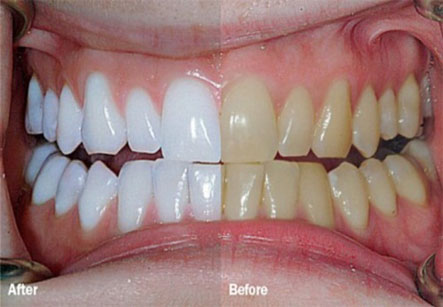Chemical Teeth Whitening
Introduction
It is also called as bleaching of teeth. With increasing age, exposure to minerals causes the teeth to darken. Some foods, drinks or tobacco products impart yellowish brown color to teeth. Also, some medications or bacterial chemicals cause such discoloration. This can affect the appearance of a person.
The dentists have developed various techniques for treating discoloration and helping their smiles improve. Chemical whitening is an important technique for achieving this. But a few things should be kept in mind that the chemical whitening is not a solution for all types of discoloration, for example, darkening caused by cavities or infection. Similarly, chemical whitening does not work on all stains.
Procedure of whitening
The teeth are first checked by a dentist before undergoing chemical whitening. The dentist examines the patient thoroughly noting carefully the condition of teeth, presence of any restoration and its condition and also condition of other oral tissues. A history regarding general health and allergies as well as dental history should be taken. Some dentists also take a baseline X-ray to determine the condition of teeth and bones.
We have all the information you need about public and private dental clinics that provide Chemical Teeth Whitening in Iran, Islamic Republic Of

In-Office chemical teeth Whitening (Bleaching):
In this procedure, the bleaching is done by a professional dentist. The dentist applies a high concentration of oxidizing gel to the teeth. Then the teeth are exposed to a beam of bright white light. This causes a specific reaction that causes the gel to penetrate the outer layer of the teeth called enamel thus removing the permanent embedded stains. This is a highly effective procedure and can be performed in one or two visits to the dentist.
At-Home Chemical Whitening (Bleaching):
Some patients prefer bleaching at home. In this procedure, the dental professional provides a plastic tray containing a low concentration of oxidizing gel. This tray should be applied to the teeth for a short time producing quick results. But an even and full tooth exposure to the gel should be ensured. The time period of exposure is about 15 to 20 minutes. This procedure can be repeated once again. The gel is regularly applied by the patient over a few weeks or months using the tray. This method can also be used for follow up after first at-office procedure.
This is a gradual method and less noticeable to others. Some patients may develop gum sensitivity or discomfort after the gel treatment.
This bleaching gel contains chemical called carbamide peroxide in a concentration between 10 to 44 percent equivalent to 3% to 16% hydrogen peroxide concentration. It breaks down in the mouth to form hydrogen peroxide. Or else, hydrogen peroxide itself can be there in this gel.
Results
A standard course of treatment of bleaching produces a lot of improvement in the appearance of the stained teeth. But some stains do not respond to chemical treatment. Tetracycline stains the dentin so it requires prolonged bleaching. At least 6 months treatment is required in this case to get the results. Whitespots of decalcifications on the teeth can get highlighted and become more evidentafter the bleach. But after repeated applications, they become less noticeable. Chemical whitening is not advised for decayed teeth or infected gums. Bleaching is more effective for yellowish discoloration of teeth as compared to grey stained teeth. Moreover, the bleach does not work where boning is done or color filling is done.
Risks and Limitations:
Chemical whitening produces side effects like increased tooth sensitivity to various stimuli, pain and tenderness of gums, and pain in other soft tissues.
A standard course of treatment of bleaching produces a lot of improvement in the appearance of the stained teeth.
Another side effect is possibility of over treatment. In this case, a gray translucency appears in the teeth. There is a very low incidence of this side effect. Over extended bleaching process can also cause this.
There is a small risk of ingesting the chemical gel provided by the dentist at home treatment sessions. This is mostly prevented by perfect fitting of the tray around the teeth. But when ingested, it may cause nausea, vomiting or burning sensation. In such cases, immediate medical help is necessary.